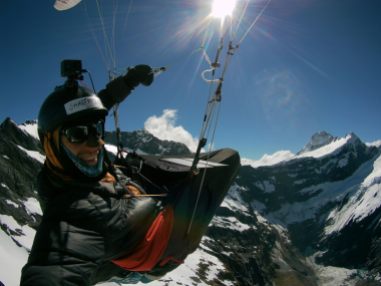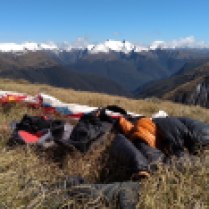
Near Wye creek, 5 Nov 2018
I’ve had a pretty good run but I have to return to work slightly earlier than I would have liked, so there’s been a squeeze on the New Zealand trip to earlier than normal. As opposed to last year, this time there is plenty of snow in the high country. The weather has been wild too, with a full two weeks waiting to take the wing out of the bag (well, including some time in the North Island as well). In the last several days I’ve had some good flying though and I’ve had time to think about a few things.
One of the things I keep saying is that despite having flown all around here for a decade, there are still some valleys I discover for the first time each season. I’ve been really spoilt lately, for example in the USA trip there was only one site (Walts) I flew twice, and in Canada I only twice passed by familiar mountains (in a completely different direction). This is a key attraction to flying for me – to explore new territory. New Zealand however remains the “best place to fly” – not because it is reliable or easy, but because it is technically interesting, stunning and remote, and above all, special.
The first flight was meant to be from my mates farm in the hills behind Queenstown. A more vigorous than expected front meant we needed an extra day for it to clear and rivers to drop however, so I changed the plan to fly over it instead. It took me many seasons in New Zealand to start stringing together decent cross countries but now I like to fly fast. How low can you go? Often the answer has been, not that low.
I’ve divided my flying into three categories, which I try in turn:
- Break some kind of record – launch as early as possible (or earlier), charge off into the distance, and often take risks with an all or nothing approach. The 200km FAI is the kind of flavour of the month here in terms of motivation. Flying fast and turning no more than absolutely necessary is great fun, and taking strategic risks lets you explore the limits of what is possible. It also means you deck it early on many occasions – but it’s good practice to get back up the hill and have another flight. The downside of this approach is that you can get drawn into the xcontest trap, where you start to worry too much about the numbers. Competition with your mates is great but its a slippery slope if it starts to take away the enjoyment of it. But I spend a lot of time looking at maps and imagining what might be possible so I have to do it justice – and I think you should give every day a chance.
- Do something spectacular – if the day is a late start, or you get stuck somewhere and an achievement based flight is now off the cards, then you’re off the hook! Go and do something cool. A good example of this is back in January 2016 when Bryan flew the triangle record, and I bombed out. Bummer to waste the afternoon bashing through scrub but in the evening I had an amazing flight past the Earnslaw glacier and then around the back and over the top. Particularly if the day is good but you messed it up somehow, use the opportunity to explore a new place and feast on scenery.
- Character building – if the day wasn’t so great to begin with then instead of trying to fly the same old A to B route you can change tack and build your skills instead. Low and tricky days are good for honing flying techniques or experimenting. Sometimes it’s good to try something you think won’t work, particularly if you know you can recover, because you might discover some kind of confirmation bias you had. You might be working on some subjective internal piloting quality or you might just be having a ball throwing wingovers.
Going with this pattern, on day one I took off from above Moke lake as soon as I thought I’d get away with it. Cloud base was still very low, and thermals were close together. Despite shade the cold airmass was turbulent and active. I was hanging on by the skin of my teeth until I got high behind Coronet, where I then glided off to behind Arrowtown without another climb. Landing in the valley the day was cooked for me but I had a few flights hopping along ridges and scratching out from really low. Finally where I landed was full of snow and shaded out so I climbed up for a forward launch to a drier place to spend the night. My main mistake for the day was electing to fly deeper in the mountains when cloud shading was an issue.
The next day looked better than expected – a nor’westerly was building. I bombed out initially but used the chance to hut bag, before racing up to launch over some bluffs where I climbed straight out. Then the challenge was to cross the Pisa range without breaking airspace. Basically it was like flatland flying, really low. After soaring near the top I didn’t manage, but flying back out again (landing to dodge a shower) was great fun. And out. Again it was new territory for me.
The third day brought thick low cloud but was flyable in the afternoon, and perhaps if I was better prepared I would have positioned myself somewhere interesting for the following day, which looked to be much better – a drier airmass. It was instead my good fortune to meet a young crew of pilots from Canterbury, who were keen for a hike up Roy’s peak and even agreed to an early start.
Racing ahead a little up Roy’s peak when cycles fanned up the face, I was quickly flying up Roy’s peak from just before 10am. [TRACK ROYS CASCADE] Definitely a flag for trying a record. Cloud base was loitering around End Peak so I scratched the over the top idea and contoured the Matukituki past Treble cone below the height of pub corner launch. I was making reasonable progress but some partial high cloud moved in, so I didn’t waste too much time getting high. Unfortunately though I pushed too much and ran out of altitude near Cascade hut in the West Matukituki in some very green pastures.
- Red rock, Shotover
- West Matukituki
- East Matukituki from over my favourite ridge
Within an hour and a half of touching down I was thermalling up in better conditions west of the Shotover saddle. [TRACK CASCADE MAKARORA] As I reached the height of the Tyndall ridge, I felt the westerly. In fact I hadn’t missed much with the attempted triangle – as suspected the wind was a bit strong. Nevertheless I was cheeky and thought I might sneak over the divide at the head of the West Matukituki. As I crossed short of Gloomy gorge though I was swept up by a strong northerly that almost dumped me at the same landing as before – where it had been calm – but now I could soar back up where I’d just walked. Flying out towards the road end I was very low but made a last gasp glide for my favourite ridge, next to Rob Roy stream – and it worked!
From there I bumbled around the eastern side of the Aspiring massif, watching cloud fall over the ridges just in front of me. I was enjoying the spectacular part of the flight. Next phase was an aborted glide towards the head of the East Matukituki – skills building – followed by flopping over ridges low, and sifting around for climbs in a cross downslope breeze. This was likely slower than following the continuous sun and wind facing ridge opposite but it kept me honest. Maybe it made me a better person? It certainly made me more appreciative when I drifted over the ridge to connect with the well formed climb under Mt Albert’s promising cloud that had been beckoning for the past hour.
More bashing cross headwind around spurs into the night followed, and with lots of snow up high I was eventually too picky and landed in the depths of the valley, a short hitch to the Brewster track no easy feat in growing darkness.
Generally the next day was mostly too windy around Southern Lakes from what I gather. It was still (calm) up at Brewster hut though, and it started later with no clouds on the inner ranges for the entire day. [TRACK BREWSTER PUKAKI] Once I climbed out to the height of the peaks I was able to soar the westerly a good way along the snowy ridge to Mt Brewster. Crossing the Hunter, I remembered making a similar move last year, but forgot exactly how it went. I think most piloting is done subconsciously and sometimes I trust the brain to get down to business and store everything away on its own, but there is surely added value from manually reprocessing things by mentally reviewing things. One way I tend to do this is by editing videos – something I haven’t done since last season!
Working my way north to Huxley was difficult as expected. Sharp craggy ridges conspiring with down valley flow to form blocking ramparts on my route. Stable conditions meaning I never was able to get high and fly far over the top. Then when I reached the Hopkins, the wind really announced it’s arrival with dust plumes high in the valley. There was some decent turbulence in the lee of the Neumann range but I’ve done enough flying on this wing to be pretty confident with it in just about anything.
I arrived on the Ben Ohau’s low but soared up as if on an elevator. Ducking into a side valley I escaped some of the wind but it was difficult to get enough height over the rocky scree mounds to pop over the back. Finally I managed and selecting a likely point, I managed to connect with some lift over the back – perhaps wave, although I cannot be sure.
Hopeful for a blue thermal in the Mackenzie it was actually really stable down there, and surprisingly calm. I even landed in a direction that would have been completely tail wind. Nice pleasant sunshine though and a very fast hitch back to Queenstown, one and a half lifts with barely any waiting (didn’t have time to put on my shoes or finish a sandwich).
The rest of the forecast looks abysmal, by the way! Makes me happy to have many times dispensed the same advice – don’t come to New Zealand just to fly, you must always have a Plan B!





























